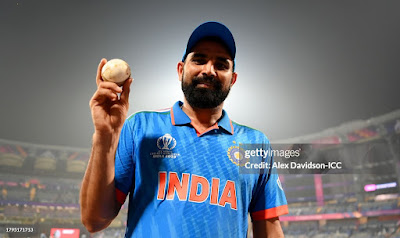Between Johannesburg 2018 and the World Test Championship Final in 2023, India boasted a five-man quality bowling attack in Ishant, Shami, Umesh Bumrah, and Siraj — a group that helped India win overseas, dominate at home, and reach two WTC finals. That phase was the golden era of India’s pace revolution, powered not just by skill but by aggression, fitness, and consistency across formats and continents
Mohammed Shami ‘s international career
seems to be over
Ishant
Sharma, Mohammed Shami, Jasprit Bumrah, and Mohammed Siraj — four world-class
pacers operating in unison — made batsmen dance to their tune. Never in their
wildest dreams could Indian cricket fans have imagined such a scenario. For
decades, India was known for its legendary spinners — until the arrival of
Kapil Dev, who inspired a generation of fast bowlers to bend their backs on
slow, unresponsive Indian pitches.
In
the 1990s, India had Javagal Srinath and Venkatesh Prasad, and in the early
2000s, the likes of Zaheer Khan, Ishant Sharma, Irfan Pathan, Sreesanth, and
Munaf Patel emerged. While they produced some memorable performances — at
Johannesburg (2006), Trent Bridge (2007), Perth (2008), Hamilton (2009), and
Durban (2010) — India's pace attack still lacked the sustained threat needed to
dominate consistently. Despite these occasional successes, it was still the
spinners who were primarily relied upon to win matches, even in overseas
conditions..
The Foundation
Things began to change after India’s tour
of Australia in 2014–15. India lost the Test series 2–0 and were fortunate not
to lose the remaining two matches. Following the series, Mahendra Singh Dhoni
retired from Test cricket, and in June 2015, Virat Kohli took over as the new
Test captain. From that point onward, a new era began. Kohli, a passionate
advocate for Test cricket and winning overseas, adopted a five-bowler strategy,
allowing India to field more pacers both at home and abroad.
Assembling the Quintet one by one
For the first time, India's focus shifted
from building batting depth to strengthening the bowling unit. Mohammed Shami’s
emergence supported Kohli’s vision. He backed Ishant Sharma, who had evolved
into a more complete bowler, and Umesh Yadav also raised his game. However, it
was the arrival of Jasprit Bumrah in 2018 and Mohammed Siraj in 2020 that
completed a pace attack capable of competing the best in the world.
Golden Years: 2018 to 2023 – India’s Pace
Renaissance
This five-year window marked a historic
shift in India’s bowling identity. The pace quintet of Ishant, Shami, Umesh, Bumrah,
and Siraj gave India consistent breakthroughs across continents — from
Johannesburg and Melbourne to Lord’s and The Oval. It was a dream phase,
culminating in back-to-back World Test Championship finals in 2021 and 2023.
India won the series in Australia, performed well in Sri Lanka, the West Indies, and
England,and won Tests in South Africa.
But with Ishant’s career almost over, Umesh out of favour, Shami’s return was very crucial, but his fitness and long-term sustainability have led selectors not to pick him for Tests. The Struggle the pace attack has seen in the last 2 years almost means that India’s pace attack golden years are over. India has never been able to have 3 quality bowlers at the same time, and to have 5 for almost half a decade was a luxury, something which, for even such a large country, would be difficult to replicate.
Mohammed Shami- End of Test Career, possibly International
Career
Shami,
who made his Test debut in 2013, was always seen as a promising pacer with
natural seam movement and an upright wrist position. However, it was the 2018
South Africa tour that marked the beginning of Shami 2.0. He took 15
wickets in the series, including a match-winning spell at Johannesburg,
reaffirming India’s fast bowling credibility.
Between
2018 and 2023, Shami became India’s most reliable and lethal red-ball pacer.
His ability to reverse swing the ball, strike with the old ball, and break
partnerships made him indispensable.
The White-Ball Contributor
While
Shami’s red-ball brilliance is well known, he also played a crucial role in
ODIs. As of July 2025, he has picked up 206 wickets in 108 matches at an
average of 24.05, including standout performances in the 2015, 2019, and 2023
World Cups. His strike rate remains among the best globally, underlining his
impact in middle overs.
Though used sparingly in T20Is, Shami has 27 wickets from 25 games, often stepping in during key tournaments or as an experienced backup.
2025: The
Twilight Beckons
Now, at age 35, Shami’s international future seems almost over. His appearances
have become infrequent due to workload management, emerging injuries, and the
selectors’ increasing tilt towards younger bowlers. With Ishant Sharma retired
and Umesh Yadav out of contention, only Bumrah and Siraj remain from the golden
pace attack.
India’s pace bench strength — once a proud talking point — now appears thin. While names like Mukesh Kumar, Akash Deep, Arshdeep Singh, and Prasidh Krishna hover on the fringes, none have yet taken over the mantle convincingly. The post-2023 phase has exposed India’s over-reliance on Bumrah and Siraj, both struggling at times without consistent support.
|
|
|
Shami has
been an excellent performer in ODI Cricket as well |
Mohammed Shami’s Career
|
Format |
Matches |
Balls |
Runs Given |
Wickets |
Average |
Strike Rate |
|
Tests |
64 |
11515 |
6346 |
229 |
27.71 |
50.20 |
|
ODI |
108 |
5326 |
4955 |
206 |
24.05 |
25.8 |
|
T20I |
25 |
510 |
761 |
27 |
28.18 |
18.8 |


Comments
Post a Comment